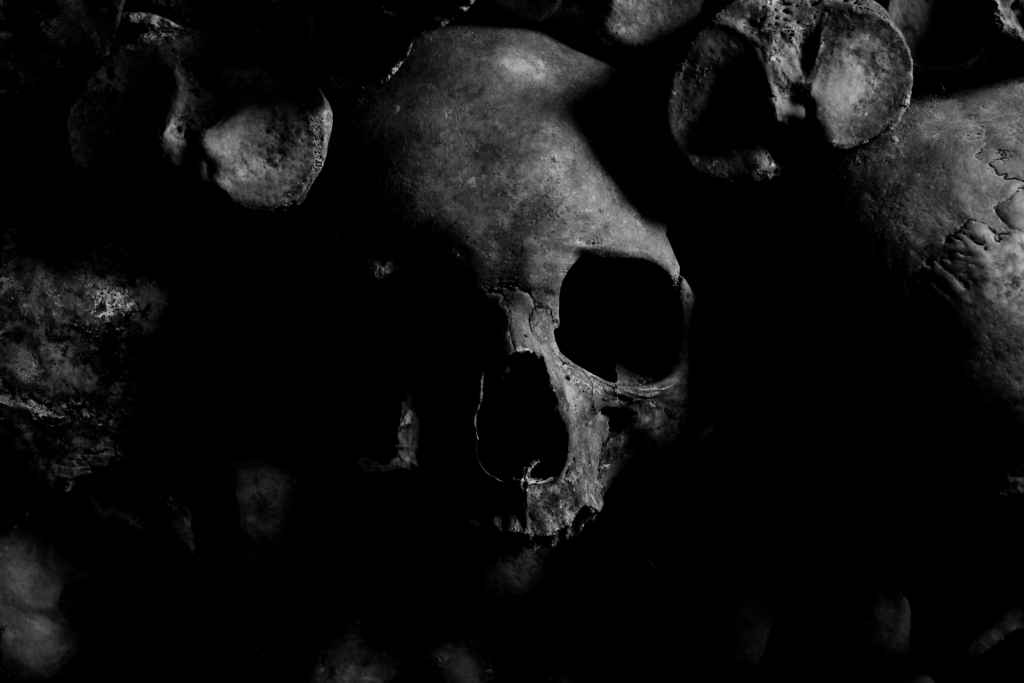The Devil’s Best Trick: How the Face of Evil Disappeared (Edition)
Prologue: The Exorcist’s Grip ()
The flickering blue light of the TV screen painted grotesque shadows on my bedroom wall. I was way too young to be watching “The Exorcist,” but there I was, huddled under my covers, eyes glued to the horrifying spectacle unfolding before me. The year on the calendar? A distant . Even now, all these years later, the memory sends shivers down my spine.
That night, Regan MacNeil’s tortured screams planted a seed of morbid curiosity in my young mind. It was the dawning of a lifelong fascination with the nature of evil—a fascination that eventually led me to question the very existence of the Devil himself.
See, they say the Devil’s greatest trick is convincing the world he doesn’t exist. And in our modern, tech-obsessed world, where reason and logic reign supreme, who could blame anyone for thinking the Devil is about as real as Bigfoot or the Loch Ness Monster? But what if that’s precisely what he wants us to think? What if our dismissal of the Devil is not a sign of our enlightenment, but a symptom of his cunning deception?
The Vanishing Devil
Let’s be real: the Devil isn’t exactly having his best moment in the sun. Gone are the days when he loomed large in sermons, haunted our collective nightmares, and inspired countless works of art and literature. Today, the Devil finds himself relegated to the dusty attics of human belief, a relic of a more superstitious age.
This wasn’t always the case, of course. For centuries, the Devil, Satan, Lucifer – call him what you will – occupied a central role in religious narratives and popular culture. He was the ultimate embodiment of evil, the tempter of souls, the architect of our downfall. But somewhere along the way, the Devil began to fade from our collective consciousness. His grip on our imaginations loosened, his presence in our lives grew fainter.
So, what happened? How did the Devil, once a figure of such terrifying power, become little more than a cultural punchline? Well, it’s complicated. The decline of the Devil’s prominence can be attributed to a confluence of factors, all converging to create a world where the existence of a literal Devil seems, well, a little extra.
The Seeds of Doubt
Meet Randall Sullivan, a hard-nosed investigative journalist who wouldn’t know a supernatural experience if it slapped him across the face with a Ouija board. Randall is a man of logic, a creature of reason, a firm believer in what you can see, touch, and, most importantly, verify. So, when rumors of demonic activity in small-town America start popping up on his radar, Randall’s initial reaction is a healthy dose of skepticism, seasoned with a dash of “Yeah, right, and I’m the Pope.”
But Randall, ever the dedicated journalist, knows a good story when he smells one. And this, my friends, has all the makings of a Pulitzer Prize-winning exposé, or at the very least, a really juicy article for The Atlantic. So, armed with his trusty notepad, a healthy dose of cynicism, and enough caffeine to fuel a small country, Randall embarks on a journey to separate fact from fiction, to expose the truth behind the hype, and maybe, just maybe, to prove that the Devil is nothing more than an old wives’ tale.
What Randall doesn’t expect, however, is to find himself staring into the abyss of the unknown. As he delves deeper into his investigation, interviewing alleged victims, speaking with experts in the field of demonology (yes, apparently, that’s a thing), and even witnessing a few unsettling events firsthand, his skepticism begins to waver. The line between belief and disbelief starts to blur, and Randall is forced to confront the possibility that maybe, just maybe, there are more things in heaven and earth than are dreamt of in his journalistic philosophy.
The Devil’s Best Trick: How the Face of Evil Disappeared (2024 Edition)
Prologue: The Exorcist’s Grip (2024)
The flickering blue light of the TV screen painted grotesque shadows on my bedroom wall. I was way too young to be watching “The Exorcist,” but there I was, huddled under my covers, eyes glued to the horrifying spectacle unfolding before me. The year on the calendar? A distant 2004. Even now, all these years later, the memory sends shivers down my spine.
That night, Regan MacNeil’s tortured screams planted a seed of morbid curiosity in my young mind. It was the dawning of a lifelong fascination with the nature of evil—a fascination that eventually led me to question the very existence of the Devil himself.
See, they say the Devil’s greatest trick is convincing the world he doesn’t exist. And in our modern, tech-obsessed world, where reason and logic reign supreme, who could blame anyone for thinking the Devil is about as real as Bigfoot or the Loch Ness Monster? But what if that’s precisely what he wants us to think? What if our dismissal of the Devil is not a sign of our enlightenment, but a symptom of his cunning deception?
The Vanishing Devil
Let’s be real: the Devil isn’t exactly having his best moment in the sun. Gone are the days when he loomed large in sermons, haunted our collective nightmares, and inspired countless works of art and literature. Today, the Devil finds himself relegated to the dusty attics of human belief, a relic of a more superstitious age.
This wasn’t always the case, of course. For centuries, the Devil, Satan, Lucifer – call him what you will – occupied a central role in religious narratives and popular culture. He was the ultimate embodiment of evil, the tempter of souls, the architect of our downfall. But somewhere along the way, the Devil began to fade from our collective consciousness. His grip on our imaginations loosened, his presence in our lives grew fainter.
So, what happened? How did the Devil, once a figure of such terrifying power, become little more than a cultural punchline? Well, it’s complicated. The decline of the Devil’s prominence can be attributed to a confluence of factors, all converging to create a world where the existence of a literal Devil seems, well, a little extra.
The Seeds of Doubt
Meet Randall Sullivan, a hard-nosed investigative journalist who wouldn’t know a supernatural experience if it slapped him across the face with a Ouija board. Randall is a man of logic, a creature of reason, a firm believer in what you can see, touch, and, most importantly, verify. So, when rumors of demonic activity in small-town America start popping up on his radar, Randall’s initial reaction is a healthy dose of skepticism, seasoned with a dash of “Yeah, right, and I’m the Pope.”
But Randall, ever the dedicated journalist, knows a good story when he smells one. And this, my friends, has all the makings of a Pulitzer Prize-winning exposé, or at the very least, a really juicy article for The Atlantic. So, armed with his trusty notepad, a healthy dose of cynicism, and enough caffeine to fuel a small country, Randall embarks on a journey to separate fact from fiction, to expose the truth behind the hype, and maybe, just maybe, to prove that the Devil is nothing more than an old wives’ tale.
What Randall doesn’t expect, however, is to find himself staring into the abyss of the unknown. As he delves deeper into his investigation, interviewing alleged victims, speaking with experts in the field of demonology (yes, apparently, that’s a thing), and even witnessing a few unsettling events firsthand, his skepticism begins to waver. The line between belief and disbelief starts to blur, and Randall is forced to confront the possibility that maybe, just maybe, there are more things in heaven and earth than are dreamt of in his journalistic philosophy.
Whispers in the Shadows
Randall, notepad in hand and skepticism firmly in check (for now), dives headfirst into the world of demonic claims. His journey takes him from the bustling streets of New York City to the isolated backwoods of Appalachia, each location offering its own unique brand of paranormal intrigue. He attends exorcisms, each one a sensory overload of ancient prayers, pungent incense, and the gut-wrenching sounds of tormented souls. He pores over dusty tomes on demonology, trying to decipher the language of the damned and separate legitimate historical accounts from embellished folklore.
Along the way, Randall encounters a cast of characters straight out of a supernatural thriller. There’s Father Michael, a battle-weary exorcist who’s seen more demonic manifestations than he cares to remember, and Dr. Sarah Kline, a psychiatrist who walks the fine line between science and the supernatural, convinced that some mental illnesses might have a darker, more sinister origin.
But it’s the stories of the alleged victims that truly shake Randall to his core. He hears tales of ordinary people, leading ordinary lives, who claim to have been targeted by malevolent forces beyond their understanding. A young mother describes her toddler speaking in tongues, his tiny voice filled with an ancient evil. A once-skeptical police officer recounts witnessing a possessed man contorting his body in ways that defy the laws of physics. Each story, regardless of its veracity, chips away at Randall’s carefully constructed wall of disbelief, forcing him to confront the possibility that maybe, just maybe, evil exists in forms we’re too scared to imagine.
The Science of Evil
Driven by the unsettling experiences of his investigation, Randall seeks solace in the familiar realm of science. He delves into the latest research on psychopathy, poring over brain scans and psychological profiles, searching for a rational explanation for the profound capacity for cruelty that seems hardwired into some individuals. He interviews leading neuroscientists and criminal psychologists, hoping to uncover the biological or psychological roots of evil.
The experts offer compelling, if incomplete, explanations. They point to genetic predispositions, childhood trauma, and chemical imbalances in the brain as contributing factors to violent and antisocial behavior. They speak of the dark triad of personality traits – narcissism, Machiavellianism, and psychopathy – as hallmarks of individuals who lack empathy and exploit others for personal gain.
But even the most brilliant minds in their respective fields admit that science can only go so far in explaining the depths of human depravity. Can we truly attribute the horrors of genocide, the calculated cruelty of serial killers, or the casual malice we encounter daily solely to faulty wiring or environmental factors? Or is there something more, something darker and more profound at play?
As Randall grapples with these questions, he finds himself drawn to the work of Dr. Carl Jung, the renowned Swiss psychiatrist who explored the shadowy recesses of the human psyche. Jung believed in a “shadow self” that exists within each of us, a repository of our repressed desires, fears, and primal instincts. Could it be, Randall wonders, that the Devil, rather than being an external entity, is merely a manifestation of this shadow self, a personification of the darkness that resides within us all?
The Devil’s Playground
Determined to confront his growing unease, Randall embarks on a chilling pilgrimage to locations steeped in tales of the occult and the unexplained. He travels to ancient ruins whispered to be portals to other dimensions, haunted battlefields where the echoes of past atrocities linger in the air, and abandoned asylums where the tormented souls of the forgotten still roam.
He stands in the ruins of medieval castles, imagining the horrors inflicted within their walls during the Inquisition, when the pursuit of heretics often crossed the line into sadistic torture. He visits the sites of infamous massacres and natural disasters, feeling the weight of collective suffering etched into the very fabric of these places.
In these haunted landscapes, Randall experiences a series of unsettling events that defy rational explanation. Electronic devices malfunction, strange whispers seem to emanate from the shadows, and he feels an oppressive, almost tangible presence that sends shivers down his spine.
Whether these occurrences are genuine manifestations of the supernatural or simply the power of suggestion playing tricks on his overactive imagination, Randall can’t be sure. But one thing is certain: his journey into the heart of darkness has irrevocably shaken his skepticism, forcing him to confront the possibility that maybe, just maybe, the line between the real and the unreal is far more permeable than he ever dared to believe.








